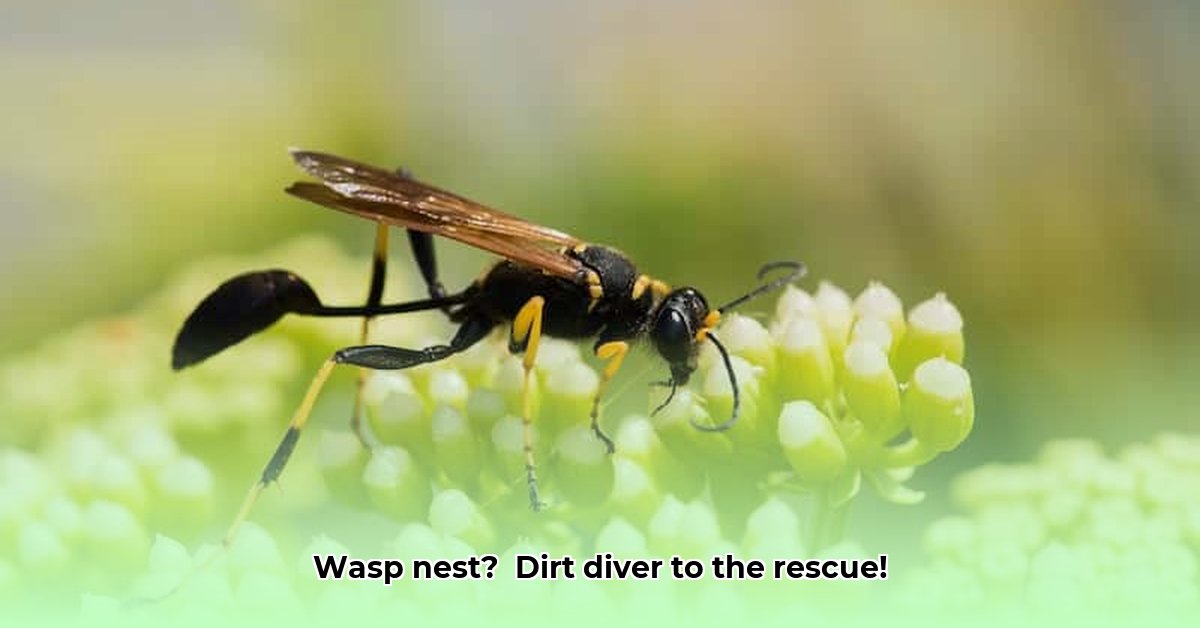# Mud Dauber vs. Wasp: A Comprehensive Guide to Identification, Removal, and Prevention
Are you noticing buzzing insects around your property? It's essential to distinguish between wasps and mud daubers. While they may appear similar, understanding their differences is crucial for effective management and safety. This comprehensive guide provides detailed information on identifying these insects, understanding their behavior, and implementing safe removal and prevention strategies. Whether you're looking to identify pests, manage nests, or implement preventative measures, this guide offers practical advice to protect your family and maintain a pest-free environment.
## Identifying Wasps and Mud Daubers: Key Characteristics and Behavior
Distinguishing between mud daubers and wasps involves understanding their unique characteristics, behavior, and nesting habits. Proper identification is paramount to ensure appropriate and safe management strategies. In this section, we provide detailed insights into how to differentiate between these insects, focusing on their physical attributes, nesting habits, and social structures.
### Understanding Mud Daubers: Solitary Hunters and Nest Builders
Mud daubers, also called "dirt daubers" are solitary wasps known for their unique mud nests and hunting behavior. These insects are generally non-aggressive and play a role in controlling spider populations. Unlike social wasps, mud daubers do not live in colonies and rarely sting unless directly threatened.
**Physical Characteristics:** Mud daubers typically have a slender body shape with a distinctive thread-like waist connecting the thorax and abdomen. They are usually black or metallic blue, with some species exhibiting yellow or green markings. Adult mud daubers typically range from 1/2 to 1 inch in length.
**Nesting Habits:** Mud daubers construct nests using mud, creating tube-like structures attached to walls, eaves, and other sheltered locations. The nests consist of individual cells, each containing a paralyzed spider to serve as food for the developing larvae.
**Behavior:** As solitary wasps, mud daubers do not defend their nests aggressively. They are primarily focused on hunting spiders and building nests for their offspring.
### Identifying Wasps: Social Structures and Aggressive Defense
Wasps encompass a diverse group of insects including social species like yellow jackets and paper wasps. These wasps live in colonies and exhibit aggressive nest defense behavior, posing a greater stinging risk compared to mud daubers.
#### Social Wasps: Colony Life and Defensive Behavior
Social wasps live in organized colonies with a queen and numerous worker wasps. These colonies can be quite large, with hundreds or even thousands of individuals. Social wasps are known for their aggressive defense of their nests and will readily sting if they perceive a threat.
**Physical Characteristics:** Social wasps typically have thicker bodies with distinct yellow and black stripes, though coloration may vary depending on the species. They range in size from 1/2 inch to 1 inch.
**Nesting Habits:** Social wasps build nests from papery material, constructing intricate structures with hexagonal cells. These nests are typically located in sheltered areas such as tree branches, under eaves, or inside walls.
**Behavior:** Social wasps exhibit complex social behaviors and are highly protective of their nests. They will aggressively defend their territory, stinging intruders repeatedly.
### Comparing Mud Daubers and Social Wasps: Key Differences
| Feature | Mud Dauber (Solitary Wasp) | Social Wasp (Yellow Jacket/Paper Wasp) |
| ------------------ | ----------------------------- | --------------------------------------- |
| Social Structure | Solitary | Colonial |
| Nest Type | Mud tubes | Paper nests |
| Aggression Level | Low | High |
| Sting Risk | Low (rarely stings) | High (aggressive defense) |
| Appearance | Slender, thread-waisted | Thicker body, yellow/black stripes |
| Nest Location | Sheltered areas, walls, eaves | Tree branches, under eaves, in walls |
## Safe Nest Removal Techniques: A Step-by-Step Guide
Prioritizing safety is paramount when removing wasp nests. This section provides step-by-step instructions for safely removing small mud dauber nests and emphasizes when to seek professional assistance.
### Removing Small Mud Dauber Nests: DIY Guidelines
For small mud dauber nests located in easily accessible areas, the following steps can be taken for safe removal:
**Step 1: Preparation:** Wear protective clothing, including long sleeves, gloves, and eye protection, to minimize the risk of stings.
**Step 2: Nest Removal:** Use a scraper or putty knife to carefully remove the mud nest from the surface. Gently dislodge the nest to avoid damaging surrounding structures.
**Step 3: Disposal:** Place the nest in a sealed plastic bag and dispose of it properly to prevent re-establishment.
**Step 4: Cleaning:** Clean the area where the nest was located to remove any residual mud or debris.
### When to Call a Professional: Handling Large or Aggressive Nests
For large nests, nests in difficult locations, or nests belonging to aggressive social wasps, it is crucial to enlist the expertise of a pest control professional. Attempting to remove these nests independently can pose significant risks. Pest control professionals have the knowledge, equipment, and experience to safely and effectively manage these situations.
## Preventing Future Nest Building: Practical Strategies
Implementing preventive measures is crucial to minimize the likelihood of wasp and mud dauber nest establishment on your property. This section provides practical strategies to deter these insects and maintain a pest-free environment.
### Sealing Entry Points: Blocking Nesting Sites
Seal cracks, crevices, and other potential entry points in your home's exterior to prevent wasps and mud daubers from accessing nesting sites. Use caulk or sealant to close gaps in walls, eaves, and foundations.
### Eliminating Food Sources: Reducing Attractants
Keep outdoor areas clean and free of food debris, spills, and garbage. Store food and garbage in sealed containers to minimize attractants for wasps and other insects.
### Removing Standing Water: Preventing Breeding Grounds
Eliminate standing water sources around your property, such as bird baths, clogged gutters, and puddles, as these can attract insects and provide breeding grounds.
## Additional Considerations: Mud Dauber Nests Near Aircraft
Mud dauber nests near aircraft pitot tubes pose a unique safety concern, as obstructed tubes can lead to inaccurate airspeed readings. This section provides specific guidance for safely removing mud dauber nests from aircraft and implementing preventive strategies.
### Safe Removal Techniques: Aircraft-Specific Considerations
**Step 1: Inspection:** Thoroughly inspect the pitot tubes and surrounding areas for mud dauber nests.
**Step 2: Gentle Removal:** Use a soft brush or low-pressure air to gently dislodge the nest from the pitot tube. Avoid using sharp objects or excessive force that could damage the instrument.
**Step 3: Verification:** Ensure the pitot tube is completely clear of debris before operating the aircraft.
### Prevention Strategies: Protecting Aircraft from Nesting
Cover pitot tubes with protective covers when the aircraft is not in use to prevent mud daubers from building nests inside. Regularly inspect the aircraft for signs of nest building, and take prompt action to remove any nests that are discovered.
## Conclusion
By following the guidelines outlined in this comprehensive guide, you can effectively identify, manage, and prevent wasp and mud dauber infestations on your property. Remember to prioritize safety during nest removal and consider seeking professional assistance when dealing with large or aggressive nests. By implementing preventive measures, you can minimize the likelihood of future infestations and maintain a pest-free environment.
Latest posts by Chaztin Shu (see all)
- Adult Bento Box Lunch Ideas For Quick Healthy Portable Options - December 25, 2025
- Adult Bento Meal Ideas for Delicious, Easy, and Healthy Lunches - December 24, 2025
- Adult Bento Box Ideas for Delicious and Easy Lunches - December 23, 2025










